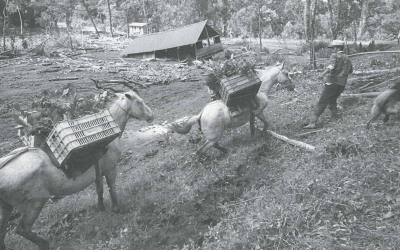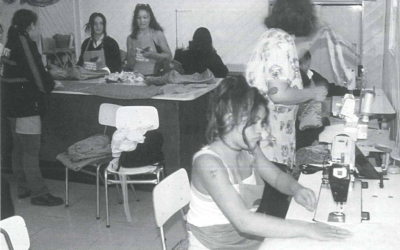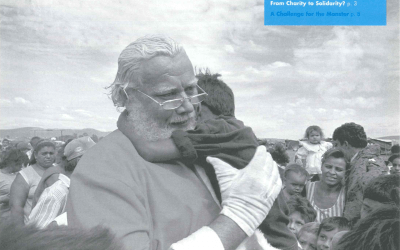Puerto Rico Community Foundation
Not-for-profit housing, teacher training, and leadership training are philanthropic goals throughout much of the Americas. At the Puerto Rico Community Foundation, we seek to achieve these goals and more by the development of social capital, by creating alliances and networks among participating organizations and the private and public sector.
This island, among the most densely populated countries in the world, faces special challenges. Officially the Commonwealth of Puerto Rico, the island has a population of 3.8 million in a perimeter of 3,500 square miles. While the average cost of an affordable house unit is $70,000.00, the mean family income in Puerto Rico is less than $10,000.00, with 59% of the Puerto Rican population on the island below the U.S. poverty level.
In the last seven years, community housing development organizations in Puerto Rico have built or rehabilitated 1,647 housing units at a market value of $145,180,000. That is, grass-roots community based housing developers generated value in excess of $100 million in 24 communities in Puerto Rico. This is one dimension of the strategy implemented by the Puerto Rico Community Foundation in more than 50 communities in Puerto Rico to increase community capital.
A Profile of the Puerto Rico Community Foundation
A group of local leaders, with the support of four U.S. foundations–Ford, Rockefeller, MacArthur, and Mott–and the National Puerto Rican Coalition established the Puerto Rico Community Foundation (“PRCF”) in 1985. The PRCF originally sought to channel philanthropic resources from corporations and individuals to address the pressing socio-economic needs of the island. Since then, the Foundation delivered to the community programs $19,843,919 in grants and built an endowment of $19 million. This one-to-one ratio exceeds by far the 5% payout rule of the Internal Revenue Service. IRS regulations require that foundations under 501c3 exemption distribute at least 5% of their total assets each year. Within the IRS framework, the Puerto Rican socio-economic context shaped a foundation highly driven towards community impact.
A 15-member board of directors governs the Foundation and closely monitors community impact through the approval of strategic and yearly goals and the scoring of progress in quarterly meetings. In addition to the chief executive officer, three department directors manage the program, development, and administration departments. Within the program area, program officers head respectively the areas of Economic Development; Community Development; and Education, Art, Youth and Health.
In 2000, the Foundation’s new leadership put forth a new vision for building community capital anchored in the development of community capacities and the strengthening of local philanthropy. The mission of the Foundation calls for developing community capacity for social transformation and economic self-sufficiency, stimulating investment in communities and maximizing the yield of each contribution. The PRCF’s four-fold strategy for increasing community capital focuses on building capacities in the human, financial, social, and physical aspects of the community.
A frequently asked question about Puerto Rico Community Foundation is what makes this foundation different from other foundations. The configuration of foundations in the United States, encompasses four major categories: national foundations, family foundations, corporate foundations and community foundations. The Internal Revenue Services defines Community foundations as “public charities,” that is, private monies used for public good. A community foundation holds assets in a number of “components” funds that may include funds intended to support particular field of interest; designated non-profit agencies; or funds for unrestricted purposes. The IRS Public Support Test for Community Foundations requires diversified community support in any given period: more than 51% of contributions to the Foundation in a three year period must come from diverse sources; a single entity cannot control the majority of assets in a Foundation.
Within this framework, the Puerto Rico Community Foundation is a “sui generis” institution in Puerto Rico; it was the first Community Foundation organized in the Caribbean and Latin America. Puerto Rican society and its philanthropic traditions shaped Puerto Rico Community Foundation in four unique and particular ways.
First, the community participates actively in the grant-awarding process. A case in point is the Youth Serving the Community Program. Last spring, a distribution committee integrated by four community youths, two Board members; and the President of the Foundation awarded 7 grant for four “project factories.” Secondly, about half of all program activity is technical assistance and capacity-building.
Thirdly, the transferal of organizational knowledge to community based organizations through on-going seminars and training on Board organizing and development. A good example is the 23 community housing development organizations trained by PRCF since the inception of the program in 1992.
Fourth, the Puerto Rico Community Foundation focuses on a new community wide philanthropic culture and an innovative set of strategies to stimulate it. Puerto Rico Community Foundation is fostering a new philanthropic culture in Puerto Rico based on long-term giving and a set of culturally specific strategies such as family funds; towns and cities funds; and stars fund.
The family fund facilitates the traditional Puerto Rican pooling of funds among family and friends to support a cause or honor the deceased. The towns and cities fund brings together residents to develop their communities. The third strategy, the “Stars Fund”, is geared toward the new wealth generated by highly talented Puerto Ricans who reach a celebrity status. Whenever possible, these strategies are linked with the Foundation’s programs through grant-making and capacity-building.
In this article, I will profile three of these programs to illustrate the dynamics between grant-making and capacity building strategies, and their impact on the community.
The Consortium for Community Economic Development
The Consortium for Community Economic Development, the primary program for the development of financial assets, brings together seven banks, three foundations, and one university in a concerted effort to support community development organizations. The Consortium also follows Puerto Rico Community Foundation’s two-fold strategy for developing community capital: grant-making and capacity building, focusing on three components: grants, education and training, and lending. Carefully crafted grants are awarded to enhance organizations’ internal capacities for economic development. Many organizations used the grant as seed money for developing their economic development units or to pay for economic development specialists in existing units. The education and training program is aimed at building the capacity of community organizations through training in business and leadership development. The lending program aims to develop financing skills in Community Development Organizations (CDOs).
In the year 2000, PRCF commissioned a study of 11 of the 17 organizations supported by the Consortium to assess community impact. The assessment showed that the ratio per dollar invested was $1 to $9.66. That is, for each dollar awarded by to Consortium the organizations generated an additional $2.68 for operational funds; $1.57 for loans to businesses; $1.86 for housing repair loans and $3.55 as avoided cost. The organizations leveraged over $13 million in added value to their community based on the initial PRCF investment of $1,357,861.
The following table summarizes the impact on the financial, social, physical and human capital.
- Table I – Summary of Impact
- Business created or sustained 44
- Existing businesses to which services were offered 314
- Initiatives of self-employment that were generated 36
- Jobs created 129
- Number of loans awarded 27
- Total amount of loans awarded to businesses $2,137,128
- Individuals oriented for home acquisition 9,560
- Total number of housing loans awarded or facilitated 119
- Total amount of housing loans awarded $2,526,706
- Avoided cost for the sale and rent of social interest housing $4,565,575
The Middle School Renewal Program
The flagship program for the development of human capacities is the Middle School Renewal Initiative, seeking to encourage innovation in education to improve student retention and academic performance. The program focuses on school re-structuring and teacher education. The program organizes planning teams in schools to implement four guiding principles:
- Strengthening of the learning community
- Integrated curriculum based on student experience
- Peer education among teachers
- Digital technology as a teaching strategy
After three years in the program the first eight schools reported significant increases in “As” (23%) and “Bs”(13%). A significant reduction in “Ds” (14.5%) and “Fs” (32.2%); and 36% reduction in teacher absenteeism. In the course of seven years, the Foundation invested $210,000.00 in 17 schools. Through government funding, the Foundation will expand to 100 schools, representing a 25% of the 400 middle schools in the system.
The Community Housing Development Organizations
Community Housing Development Organizations (CHDO) Program is the Foundation’s signature program for the development of physical assets. Since 1992, the program has invested $894,184 in building organizational capacity and providing technical assistance and training to 24 community housing organizations. This program aims to organize and prepare grass-root housing developers to produce housing units for low income people in Puerto Rico. Through creative financing that combines government subsidies, tax credits, and private financing, the CHDOs have been able to produce housing units at affordable prices.
Social capital is captured in all three programs through alliances and networks formed between participating organizations and the private and public sector. The CHDOs for example, organized the first Community Housing Association in Puerto Rico. Another case in point is the $120,000 saved through the collective purchase of health insurance for its members by the Camuy Merchant Association. The 5.43% interest rate obtained through the re-lending program is another example of significant savings compared to the 10% average market rate in commercial loans.
Lessons, challenges and opportunities
1. Building of local philanthropy
Since its inception, PRCF has been a highly effective conduit and manager of external funding. Of the 42 million dollars raised in 16 years, a significant percentage came from U.S. corporations in Puerto Rico and foundations. This is a very successful role we have played in the past and will continue doing it in the future. Yet, in our vision of the future our positioning in this relationship will change. PRCF will empower the local community to become an active co-investor in funding long-term high impact projects. External funding will be paired with local funding to launch new initiatives that will have a systemic impact in the Puerto Rico society.
The local donor in Puerto Rico is more inclined to community impact and less to the mechanics of giving. Tax laws in Puerto Rico do not provide a significant impetus to giving. Yet the Puerto Rican donor is willing to contribute to programs and initiatives that will generate significant change in the future. This lesson provides the basis for the design of the soon to be launched endowment campaign.
Four major initiatives will drive PRCF’s new endowment campaign, including the middle-school initiative mentioned above. The second endowment driver will be the Community Development Leadership Center to train community leaders in the most sophisticated strategies for building community assets and change. Scholarship program and a Community Fellows Program will stimulate both students and mid career leaders in this area.
Then there’s the “Town Fund” for Community Development to provide an opportunity for citizens in Puerto Rico’s 78 municipalities to set up funds for community programs. The fourth driver will be the “All for Puerto Rico Fund.” This will be an opportunity for all Puerto Ricans–in Puerto Rico and the U.S.–to support, on a sustained basis, high impact programs in the fields of education, and the community economic development, housing and health.
The Puerto Rico Community Foundation is an opportunity for partnering and citizens participation. The Foundation new stage is an open and ongoing invitation to engage with local residents in forging a new future for the island.
Spring 2002, Volume I, Number 3
Related Articles
Obras de Infraestructura Básica de Fácil Ejecución a través de la Autogestión
En el Ecuador rural y en las zonas citadinas marginales, la carencia de servicios básicos se ha convertido en un mal endémico no resuelto hasta …
Responsabilidad Social Empresarial: Algunos Hechos Que Cuentan
La Responsabilidad Social Corporativa (RSC) es una temática más bien nueva en Chile. Aún cuando se encuentran acciones filantrópicas desde tiempos de la colonia, la relación de la …
Algunos Casos en Chile
Un caso fue José Tomás Urmeneta, un empresario del siglo XIX quien, en un momento de auge del sector agroexportador chileno, en su testamento dejó asignados recursos para …




